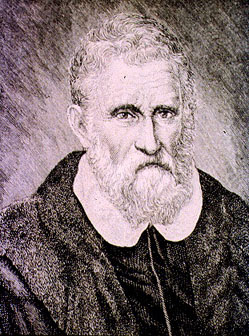

 ("I" refers to Marco Polo himself)
("I" refers to Marco Polo himself)
I was not the only only medieval European to travel the Silk Road , but probably I am the most famous. I lived in Venice, an important center for commerce with the East, by which my father and uncle prospered.In 1271, when I was 17 years old, I joined them on a journey that would last twenty-four years and take me more than 24,000 miles, through the bleak deserts and rugged mountains of the Middle East and Central Asia, and further than any of his European predecessors—to China and the court of Khubilai Khan (1214–1294), the ruler of the Mongols (called "Tartars" by Marco) who controlled the largest empire in the world. I had mastered several languages, and became the trusted agent of Khubilai Khan and stayed at his court for seventeen years. To allow me to travel freely through the vast Mongol territories, Khubilai gave me a passport, similar to one now in the Metropolitan Museum. But instead of being made of iron and silver, my passport was made of gold.
Khubilai Khan During our stay in the East, my father, uncle and I acquired great wealth in jewels and gold. Khubilai Khan was reluctant to let his visitors return to Venice. However, we finally commenced our arduous journey home when Khubilai, in 1292, allowed us to escort a Mongol princess to Iran where she was to be wed. We endured great hardship on the return journey, including the deaths of many of their companions. As soon as we left Mongol jurisdiction, in Trebizond,we were robbed of much of their wealth. We finally arrived in Venice in 1295, to the surprise of relatives and friends who had thought we long dead. Some time after 1298, I was captured and imprisoned during a regional war between Venice
During our stay in the East, my father, uncle and I acquired great wealth in jewels and gold. Khubilai Khan was reluctant to let his visitors return to Venice. However, we finally commenced our arduous journey home when Khubilai, in 1292, allowed us to escort a Mongol princess to Iran where she was to be wed. We endured great hardship on the return journey, including the deaths of many of their companions. As soon as we left Mongol jurisdiction, in Trebizond,we were robbed of much of their wealth. We finally arrived in Venice in 1295, to the surprise of relatives and friends who had thought we long dead. Some time after 1298, I was captured and imprisoned during a regional war between Venice
and its chief trade rival, Genoa. By a fortunate coincidence, my cellmate was one Rustichello of Pisa, a writer of romances and chivalric lore. The story of exotic places and customs that I dictated to his fellow prisoner, which he titled A Description of the World, became one of the most popular books in medieval Europe. Many did not believe the stories, but others were inspired, including Christopher Columbus, who owned a copy of my book.
My extraordinary journey to the East could not have happened had not the diverse, nomadic Mongol tribes come together in 1206 under one of history's most feared rulers, Temujin, who was enthroned as the Genghis ("universal") Khan ("ruler") of all the Mongols. In the early thirteenth century, the Mongols swept through and conquered lands from China and Korea in the east and through Persia, Iraq, and Turkestan to Bulgaria, Russia, and Poland in the west. The onslaught of the ferocious Mongol horsemen was terrifying. However, in a short period of time, control of most of Asia by the Mongols—the so-called Pax Mongolica ("Mongolian Peace")—created an environment of tremendous cultural exchange. By the time of my travels, under the rule of Genghis Khan's illustrious and enlightened grandson, Khubilai, the Mongol Empire was at its peak. The Mongols traditionally led a nomadic lifestyle, which meant that as the seasons changed, the people moved with their sheep, goats, yaks, and camels in search of food and water. Because they only lived in a place for a short period of time, their homes were portable tents (called ger or yurt) made of wood piles, canvas, and felt. Furthermore, all their possessions had to be small and easy to carry. With few large cities and a mobile lifestyle, Mongol society had few industries and relied on more sedentary neighbors, such as the Chinese, for manufactured products, such as textiles, ceramics, and metalwares, as well as for farm-grown food. In exchange, the Mongols traded horses, animal skins, and meat.
Once he succeeded in unifying the Mongol tribes, Genghis Khan and his tightly disciplined army conquered lands in northern China and Central Asia. Genghis Khan was also a far-sighted leader who developed policies that would aid in governing and in shaping the economies of the growing empire. Under his rule, Uyghur script was adapted for the writing of Mongolian, previously an unwritten language. A policy of religious tolerance was pursued to win over the newly conquered native populations. And foreigners were recruited for skilled administrative positions for which the Mongols lacked experience. The nomadic lifestyle of the Mongols had prevented the development of an artisan class, but Genghis, aware of the need for craftsmen, spared their lives when the Mongols conquered their lands, freed them from manual labor and taxes, and moved them to new areas. When the Mongols established their huge empire, they continued their traditional support of merchants and craftsmen, which resulted in the greatest expansion of trade and tribute in Eurasian history. Traders, as well as diplomats and missionaries, traveled with few hindrances across Mongol domains, resulting in the first direct contacts between Europe and China. European missionaries and merchants, the most famous being who is me, Marco Polo, voyaged all the way to China, and Asian products—silks and spices—reached Europe, leading Europeans to seek a sea route to the East and its treasures.